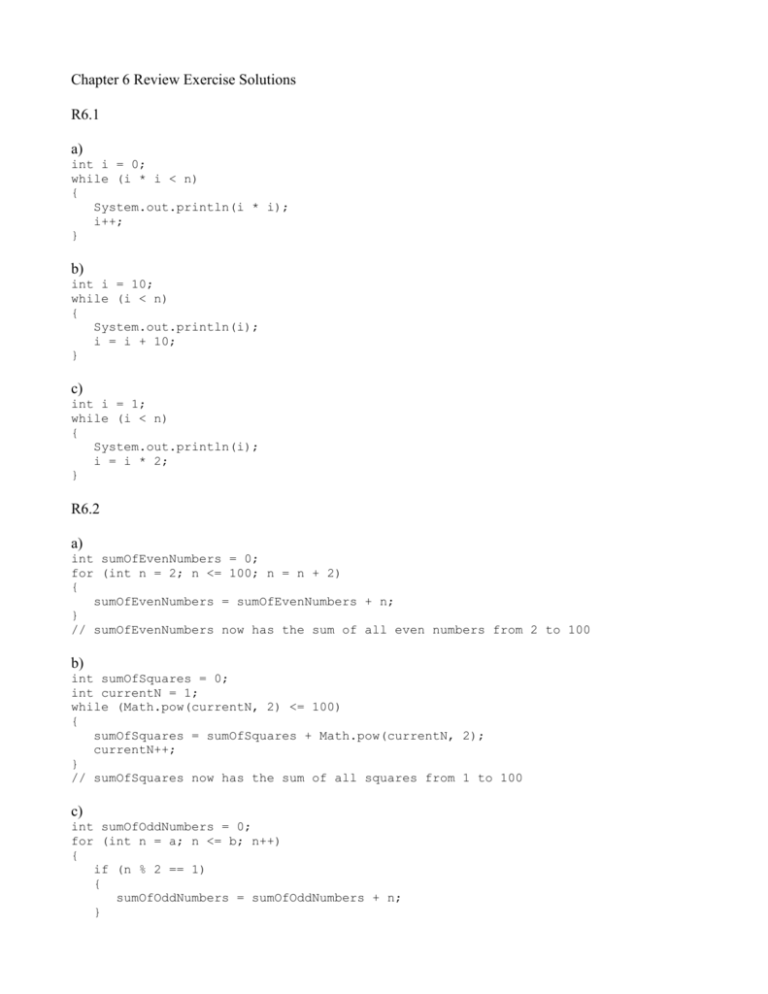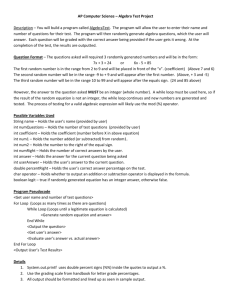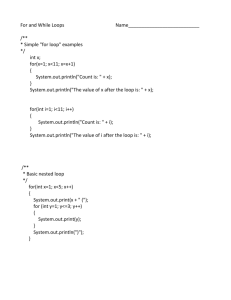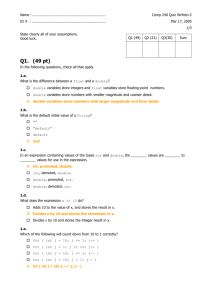ch 6 review
advertisement

Chapter 6 Review Exercise Solutions
R6.1
a)
int i = 0;
while (i * i < n)
{
System.out.println(i * i);
i++;
}
b)
int i = 10;
while (i < n)
{
System.out.println(i);
i = i + 10;
}
c)
int i = 1;
while (i < n)
{
System.out.println(i);
i = i * 2;
}
R6.2
a)
int sumOfEvenNumbers = 0;
for (int n = 2; n <= 100; n = n + 2)
{
sumOfEvenNumbers = sumOfEvenNumbers + n;
}
// sumOfEvenNumbers now has the sum of all even numbers from 2 to 100
b)
int sumOfSquares = 0;
int currentN = 1;
while (Math.pow(currentN, 2) <= 100)
{
sumOfSquares = sumOfSquares + Math.pow(currentN, 2);
currentN++;
}
// sumOfSquares now has the sum of all squares from 1 to 100
c)
int sumOfOddNumbers = 0;
for (int n = a; n <= b; n++)
{
if (n % 2 == 1)
{
sumOfOddNumbers = sumOfOddNumbers + n;
}
}
//sumOfOddNumbers now has the value of all odd numbers between a and b
d)
int nLeft = n;
int sumOfOddDigits = 0;
while (nLeft > 0)
{
int digit = nLeft % 10;
if (digit % 2 == 1)
{
sumOfOddDigits = sumOfOddDigits + digit;
}
nLeft = nLeft / 10;
}
// sumOfOddNumbers now has sum of all odd digits in n
R6.3
a)
i
0
1
2
3
4
5
j
10
9
8
7
6
5
n
0
1
2
3
4
5
b)
i
0
1
2
3
4
5
6
7
8
9
10
j
0
1
2
3
4
5
6
7
8
9
10
n
0
1
4
9
16
25
36
49
64
81
100
j
0
n
0
c
i
10
9
8
7
6
5
4
3
2
1
0
1
2
3
4
5
6
7
8
9
10
8
14
18
20
20
18
14
8
0
-10
d)
As the trace table shows, i will never equal j since they pass each other at the 4-6 to 6-4 mark. The
trace table stops right below this point to indicate it is an infinite loop.
i
j
n
0
10
0
2
8
1
4
6
2
6
4
3
8
2
4
…
…
…
R6.4
a) 1 2 3 4 5 6 7 8 9
b) 1 3 5 7 9
c) 10 9 8 7 6 5 4 3 2
d) 0 1 2 3 4 5 6 7 8 9
e) 1 2 4 8
f) 2 4 6 8
R6.5
An infinite loop occurs when the terminating condition in the loop never evaluates to false. How you
stop an infinite loop on your computer depends on your operating system and your IDE. For example,
in the Eclipse IDE there is a red “TERMINATE” button that will stop any Java program at any time.
R6.6
first
true
false
value
minimum
4
7
-2
-5
0
4
-2
-5
-5
output
-5
R6.7
An off-by-one error occurs when you incorrectly initialize or terminate a loop by one unit. A common
example occurs when looping through a Java String. The programmer may forget that character
positions start at 0 rather than 1 and start his loop one character beyond the actual start of the String.
R6.8
A sentinel value is a particular value that is used to indicate the end of a sequence. By necessity the
sentinel cannot be a valid member in the sequence. For example, an employer may be interested in the
average age of her employees. She could write a program that reads a series of ages and terminates
when it reads a negative number. Since there are no employees with a negative age it makes an
appropriate sentinel value.
R6.9
Java supports three types of loop statements: for, do, and while. Use a for loop if you know in
advance how many times the loop should be repeated. Use a do loop if the loop must be executed at
least once. Otherwise, use a while loop.
R6.10
a) 10 times
b) 10 times
c) 10 times
d) 21 times
e) This is an infinite loop
f) 11 times
g) 7 times
R6.11
Print out calendar header with days of week: Su M T W Th F Sa
// The -2 indicates that the first week doesn’t start until Wednesday
current day = -2
last day of month = 31
// Let 0 represent Su and 6 represent Sa
weekday = 0
while (current day <= last day of month)
if (current day > 0)
Print current day followed by a space
else
Print three spaces
Add one to current day
Add one to weekday
// Check to see if we’ve printed out a week, print a newline if we have
if (weekday == 7)
Print a newline to go to next week
weekday = 0
R6.12
Print out table header
for (celsius = 0; celsius <= 100; celsius = celsius + 10)
Print right aligned celsius
Print a | character
fahrenheit = (9/5) * celsius + 32
Print right aligned Fahrenheit
Print newline
R6.13
// Initialize current name to something other than -1
current name = “”
read name from input into current name
counter = 0
total score = 0
average score = 0
read next input into current score
while (current score != -1)
counter = counter + 1
add current score to total score
read next input into current score
average score = total score / counter
print average score
print newline
Trace Table:
name
Harry Morgan
current counter total average
score
score score
94
1
94
0
71
2
165
0
86
3
251
0
95
4
346
0
-1
0
86.5
R6.14
// Initialize current name to something other than END
current name = “”
read name from input into current name
while (current name != “END”)
current score = 0
total score = 0
read next input into current score
while (current score != -1)
add current score to total score
read next input into current score
print current name and total score
print newline
Trace Table:
name
Harry Morgan
Sally Lin
current total
score score
94
94
71
165
86
251
95
346
-1
99
99
98
197
100
297
95
392
90
482
-1
R6.15
int s = 0;
int i = 1;
while (i <= 10)
{
s = s + i;
i++;
}
R6.16
int n = in.nextInt();
double x = 0;
double s;
s = 1.0 / (1 + n * n);
n++;
x = x + s;
while (s > 0.01)
{
s = 1.0 / (1 + n * n);
n++;
x = x + s;
}
R6.17
a)
s
1
2
3
4
5
6
7
8
9
10
n
1
1
1
1
1
1
1
1
1
2
b)
s
1
2
4
7
n
1
2
3
4
11
c)
s
1
2
4
7
11
16
22
29
37
46
56
67
79
92
106
121
137
154
172
191
211
n
1
2
3
4
5
6
7
8
9
10
11
12
13
14
15
16
17
18
19
20
21
R6.18
a) 2 4 7 11 16
b) 4 9 16
c) 10 7
R6.19
a) 10
b) 6
c) 3
d) 0
R6.20
If a programmer needed to print a list of numbers starting from a to b it is easier to read if the for loop
has a and b as symmetric bounds, like this:
for (int i = a; i <= b; i++)
If a programmer needed to loop through all the characters in a string, it is easier to read if the loop has
asymmetric bounds based on the length of the string, like this:
for (int i = 0; i < myString.length(); i++)
R6.21
Storyboard for incompatible units.
What unit do you want to convert from? cm
What unit do you want to convert to? gal
Sorry, cannot convert from one unit to the other.
What unit do you want to convert from? cm
What unit do you want to convert to? in
Enter values, terminated by zero
10
10 cm = 3.94 in
0
What unit do you want to convert from?
R6.22
Storyboard showing how valid unit types can be displayed.
What unit do you want to convert from? leagues
Sorry, invalid units. Valid unit types are:
in, ft, mi, mm, cm, m, km
oz, lb, g, kg
tsp, tbsp, pint, gal, ltr
What unit do you want to convert from? cm
What unit do you want to convert to? in
Enter values, terminated by zero
10
10 cm = 3.94 in
0
What unit do you want to convert from?
R6.23
Storyboards from Section 6.6 with a new menu.
Converting a Sequence of Values
What would you like to do?
Enter 1 to convert units
Enter 2 for program help
Enter 3 to quit
1
What unit do you want to convert from? cm
What unit do you want to convert to? in
Enter values, terminated by zero
30
30 cm = 11.81 in
100
100 cm = 39.37 in
0
What would you like to do?
Enter 1 to convert units
Enter 2 for program help
Enter 3 to quit
Handling Unknown Units
What would you like to do?
Enter 1 to convert units
Enter 2 for program help
Enter 3 to quit
1
What unit do you want to convert from? cm
What unit do you want to convert to? inches
Sorry, unknown unit.
What would you like to do?
Enter 1 to convert units
Enter 2 for program help
Enter 3 to quit
1
What unit do you want to convert from? cm
What unit do you want to convert to? inch
Sorry, unknown unit.
What would you like to do?
Enter 1 to convert units
Enter 2 for program help
Enter 3 to quit
1
What unit do you want to convert from? cm
What unit do you want to convert to? in
30
30 cm = 11.81 in
100
100 cm = 39.37 in
0
What would you like to do?
Enter 1 to convert units
Enter 2 for program help
Enter 3 to quit
Exiting the Program
What would you like to do?
Enter 1 to convert units
Enter 2 for program help
Enter 3 to quit
1
What unit do you want to convert from? cm
What unit do you want to convert to? in
Enter values, terminated by zero
30
30 cm = 11.81 in
100
100 cm = 39.37 in
0
What would you like to do?
Enter 1 to convert units
Enter 2 for program help
Enter 3 to quit
3
(Program exits)
R6.24
Flowchart for the units conversion program in Section 6.6.
R6.25
You cannot initialize the largest and smallest variables to zero because it is possible that all of the
values entered may be either all larger than zero or all smaller than zero.
For example, if we are looking for the maximum and set largest to zero, and the values entered are 10.2, -8.1, and -7.6, the value of maximum never changes from zero, because none of the values
entered is greater than zero. The maximum number of those entered should be -7.6, but the program
would think it was 0.
R6.26
Nested loops are loops contained in other loops. This sort of structure is common when having to
process a table. One loop would process the rows while the other would process the columns in each
row.
R6.27
for (int i = 1; i <= width * height; i++)
{
System.out.print("*");
if (i % width == 0)
{
System.out.println();
}
}
R6.28
Java has a random number generator (Math.random()) which generates random numbers from 0 up to
1 (exclusive). To generate a random hour, get a random number between 0 up to 1, multiply it by 12
and cast it to an int; this gives you a random number between 0 and 11. Next, add 1 to that number to
create a number between 1 and 12 which is appropriate for the hour.
The minutes are easier, simply generate a random number between 0 up to 1, multiply it by 60 and cast
it to an int.
R6.29
This problem is easier to think about if you generate a random number to select which friend to visit.
First generate a random number between 1 and 15 (Harry has 15 total friends). Next convert the friend
numbers to state numbers. If the number is between 1 and 10, generate a 1 indicating California; if the
number is between 11 and 13, generate a 2 indicating Nevada; otherwise generate a 3 indicating Utah.
R6.30
Step into: steps inside method calls. You should step into a method to check whether it carries
out its job correctly.
Step over: skips over method calls. You should step over a method if you know it works
correctly.
R6.31
The procedure depends on the debugger. Most debuggers know about the String class and display its
contents immediately when you ask to inspect or watch a string. However, you can also display the
instance variables and inspect the value instance variable.
R6.32
This varies according to the debugger used. Typically, you inspect a variable of type Rectangle and
carry out some action (such as clicking on a tree node) to open up the display of the instance variables.
The x, y, width, and height instance variables should then be visible.
R6.33
This varies according to the debugger used. Typically, you inspect a variable of type BankAccount and
carry out some action (such as clicking on a tree node) to open up the display of the instance variables.
The balance variable should then be visible.
R6.34
The “divide-and-conquer” strategy involves stepping over the methods in main to pinpoint the location
of the failure. When a failure occurs just after a particular method (say f), then restart main, set a
breakpoint before f, step into f, and now apply the same strategy to f. Keep going until the error is
found.









